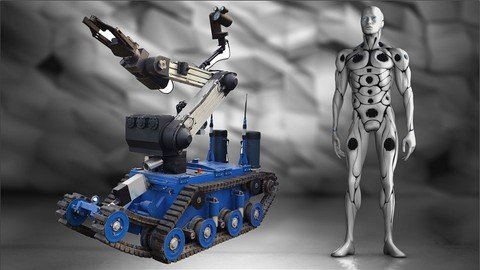Robotic Drives & Physics: Robotics, Learn By Building Iii
Original Price: $N/A
Yours FREE DOWNLOAD!!!
Author: N/A
Sale Page :_N/A
New, 3rd course with over 38,000 enrolled in the first two courses, and over a 4.5 star rating!
What you’ll learn
How do we make a robot move? What kind of ways are there to power our robots and how can we use even tiny motors to move a substantial load? How can we make things like robotic, bionic arms? These are the things we’ll explore with first hand application and practical experiments that you can perform at home to get you one step closer to designing and building robots and robotic systems.
Requirements
Fulfillment of courses 1 & 2 in the series, or a good knowledge of electricity, analog and digital electronics.
Description
Please note: Content is being uploaded through November/December. This is a new course. Thanks for your patience!Building on the knowledge you gained in the Analog Electronics and Digital Electronics modules, you’ll open even more doors to diverse careers and hobbies by learning how to physically move robots and mechatronics. Robotic drives and physics are intimately intertwined – almost the same topic in fact. And think about all the things around you that are moved or operated automatically: from the furnace and air handlers in your office building, to so many functions in your car, and then the booming robotics field in industry, mass production, even entertainment! People are needed who understand how those robots work in order to design, install, program and maintain those robots. Maybe you’re interested in building a submarine robot to dive to shipwrecks or places normally unreachable by humans. We’ll actually look at a real-world case study and use our new-found knowledge of physics to design a submarine robot to operate at depths of 600 meters or more. Or perhaps you are just interested in competition robotics like the gladiator-style battle robots which go head-to-head to destroy each other. 3D printers (of which we design and build one in course 4) are essentially robots! All of these topics involve a good understanding of robotic drive systems and physics which you will learn in this course.With over 38,000 students enrolled in the first two courses in the “Robotics: Learn by building” series, more than 2,000 five star ratings in the first course alone, students aged 8 to 60+ have enjoyed the course series and its projects.No prior knowledge of mechanics, physics or robotics is needed. You will need a good understanding of electricity & electronics and digital control and some basic math. If you have completed course 1 “Electricity and Electronics” and course 2 “Digital Electronics” you have the background you need as we will be using those skills in this course to drive different kinds of electric motors. All courses have captions for the hearing impaired. Course materials:You will need the analog electronic parts and a breadboard, which you can purchase as an accompanying kit (i.e., the Analog Electronics Kit from module I) or provide your own, as well as the parts from the digital electronics kit (i.e., the Digital Electronics Kit from module II) or provide your own Arduino controller board and some logic-level, high power MOSFET’s.You will also need the Robotic Drives & Physics Experimenter’s kit which again you can purchase as an accompanying kit or provide your own parts. The first lesson is a walk-through of what is in the kit and acts as a parts list for this module.This series of “Robotics: Learn by building” modules has an end-goal focus on the diverse field of robotics. In module I we learned the basics of electricity and electronics. In this module II you further developed your knowledge and skills to include digital electronics and practice your skills on real-life digital components. In this third course you will learn physics principles (from simple to very complex) with a specific goal of understanding and even designing your own drive systems for robots. You will learn details about different robotic drive systems you will see in commercial, industrial robots like how timing belt drives work and why they are so important in robotics, as well as the more esoteric drives like the harmonic drive – what it is an how that amazing system works.We will even look at a real-life case study as we design a submarine robot, remotely operated and able to withstand the bone-crushing operating depths of over 600 meters minimum. The unique challenges we will face will build up your knowledge so that you too can design sea-floor robots facing harsh environments to perform inspection, welding or maintenance on submarine pipes or cables.This course is the prerequisite for the module IV course where you’ll learn prototyping skills, and gain a wide variety of knowledge and skills so you can actually build your own robots and manufacture your own parts. In module IV, you’ll culminate all you’ve learned so far as you build a 3D printer from scratch, hook it up to a desktop computer and make your own plastic parts. The 3D printer is, in effect, a robot which you can then use to make parts for your other robot designs. In module V you can take your robot design and construction skills to the next level with a hands-on approach to autonomous robotic systems: learning about various sensors to know where you are and what your robot is doing, GPS navigation, basic artificial intelligence, powerful microchips known as FPGA’s where you literally design a custom circuit on the chip, vision systems and more.Lesson overview:In this course we’ll be covering:Simple machines (which all come into play in surprising ways you probably haven’t seen before)Designing an arm robotThe toggle mechanism (again, comes into play in a ridiculous number of surprising ways you probably haven’t seen before)harmonic drives, cycloidal drives, epicyclic drives, traction drivesstrength of materials & construction challengecase study: design challenges of a deep-submarine, remotely operated vehiclehydraulics & pneumatics (including building your own)air & hydraulic muscles, muscle wire servos (speed, pressure, force, position, etc…)DC motors, BLDC motors, BLDC servo motors, stepper motors, AC motors, AC servo motors, single and three phase power, electrical generationfrequency drives, PWM AC signal generationregenerative / rheostatic / dynamic braking, looking at electric vehicle design and locomotive designcounter-force systems you will encounter in industrial robotssafety around robot systems, in industry and hobbyrobot designs: articulated arm, gantry, spine, collaborativecase study: combat robotsand more!
Overview
Section 1: Introduction
Lecture 1 Whatcha gonna need: explanation of parts in the kit
Lecture 2 Physics kit table assembly
Lecture 3 Simple machines: Levers and why they are important
Lecture 4 Gears, compound gears & mechanical advantage
Lecture 5 Building our experimental gear drive
Lecture 6 Mechanical Mayhem challenge #1
Lecture 7 Strap Drives
Lecture 8 Arm robot design challenge #1, part 1
Lecture 9 Arm robot design challenge #1, part 2
Lecture 10 Backlash: The nemesis of robotics
Lecture 11 The Wedge / threads / ball screw drive
Lecture 12 Anti-backlash gears
Lecture 13 DC brushed motors
Lecture 14 Exploring real world DC motors on a forklift
Lecture 15 Back EMF
Lecture 16 Toggle mechanism and building a robot gripper
Lecture 17 Electrical generation & 3 Phase AC power
Lecture 18 Regenerative braking
Lecture 19 Regenerative braking II: A practical application
Lecture 20 Servos and feedback, part 1
Lecture 21 Servos and feedback, part 2
Lecture 22 Stepper motors
Lecture 23 Stepper Motors II: Driving them around
Lecture 24 Brushless DC (BLDC) motors
Lecture 25 Building our 3 phase H-bridge to drive a BLDC
Lecture 26 Driving BLDC in closed loop with hall effect sensors
Lecture 27 PWMAC – simulating an AC wave using PWM
Lecture 28 Hardware hacking a BLDC into an AC servo motor, part 1
Lecture 29 Hardware hacking a BLDC into an AC servo motor, part 2
Lecture 30 Submarine Robot Case Study, part 1
Lecture 31 Submarine Robot Case Study, part 2: Buoyancy Control
Lecture 32 Submarine Robot Case Study, part 3: Density and Buoyancy
Lecture 33 Submarine Robot Case Study, part 4: Pressure Vessels
Lecture 34 Strain Wave Drive, aka Harmonic Drive
Lecture 35 Robot safety & interlockings
Lecture 36 AC motors, part I
Lecture 37 AC motors, part II: Synchronous & Asynchronous
Lecture 38 DC dynamic brakes
Lecture 39 AC dynamic brakes
Lecture 40 Safety with air and fluid power
Lecture 41 Physics kit backboard assembly, part 1
Lecture 42 Physics kit backboard assembly, part 2
Lecture 43 Air tank assembly
Lecture 44 Assembling power cylinders
Lecture 45 Extra parts with power cylinders
Lecture 46 Homebuilt Power cylinder tear-down
Lecture 47 Power cylinder physics
Lecture 48 Solenoids
Lecture 49 Using our pneumatic system
Lecture 50 Measuring force from our power cylinders
Lecture 51 Air muscles
Lecture 52 Springs and animatronics
Lecture 53 Resolvers: And introduction
Those interested in robotics, electronics and electro-mechanical devices such as 3D printers (which really is a type of robot).
Robotic Drives & Physics: Robotics, Learn By Building Iii: Video, PDF´s
Download from rapidgator.net
Robotic.Drives.Physics.Robotics.learn.by.building.III.part1.rar
Robotic.Drives.Physics.Robotics.learn.by.building.III.part2.rar
Robotic.Drives.Physics.Robotics.learn.by.building.III.part3.rar
Robotic.Drives.Physics.Robotics.learn.by.building.III.part4.rar
Robotic.Drives.Physics.Robotics.learn.by.building.III.part7.rar
Robotic.Drives.Physics.Robotics.learn.by.building.III.part5.rar
Robotic.Drives.Physics.Robotics.learn.by.building.III.part6.rar
Download from Nitroflare
Robotic.Drives.Physics.Robotics.learn.by.building.III.part1.rar
Robotic.Drives.Physics.Robotics.learn.by.building.III.part2.rar
Robotic.Drives.Physics.Robotics.learn.by.building.III.part3.rar
Robotic.Drives.Physics.Robotics.learn.by.building.III.part4.rar
Robotic.Drives.Physics.Robotics.learn.by.building.III.part5.rar
Robotic.Drives.Physics.Robotics.learn.by.building.III.part6.rar
Robotic.Drives.Physics.Robotics.learn.by.building.III.part7.rar
==> Download From Mega.: (FREE DOWNLOAD)
 ***If link dead, please leave a message,or to send message to a ebusinesstores@gmail.com We will update immediately***
***If link dead, please leave a message,or to send message to a ebusinesstores@gmail.com We will update immediately***



mega link pls.
I need mega link. I am studying electronics this semester.
the links are dead
Mega link now only for MEmbership
Please read here: https://freecoursedl.com/become-a-member/
*Please let me know if you have any problem! Contact to Support via:
Telegram: https://t.me/thecoursedl
Email: ebusinesstores@gmail.com
Skype_Macbus87